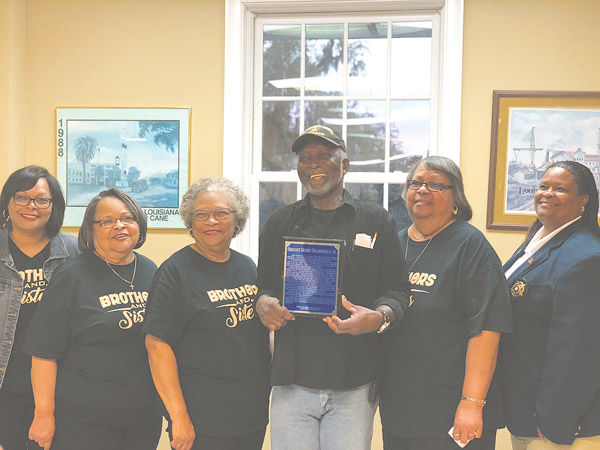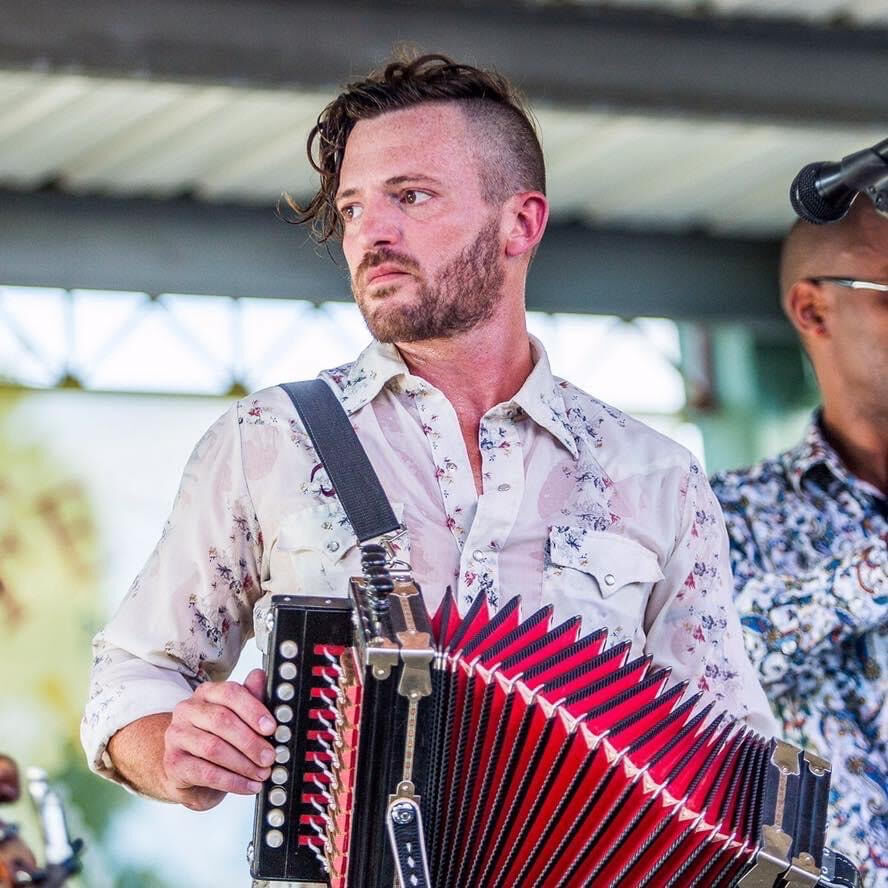Saluted Posthumously
Published 5:00 am Sunday, May 27, 2018

- Receiving the memorial award presented by Michael Bell, center, for the annual Felicite’s Humanitarian Historical Society are the daughters of Gilbert and Mary Delahoussaye. They are Diedra D. Chambers, from left, JoeAnne V. Delahoussaye, Beatrice D. Livingston, Dorothy D. Antoine and Charmaine V. Delahoussaye. Their children not pictured are Gilbert Delahoussaye Jr., Ricky Delahoussaye and the late Terry Delahoussaye Sr. and Woodrow Delahoussaye.
Honoring the memory of one who served
Memorial Day is a national holiday to remember those who served. “All gave some, some gave all” is a popular slogan without confirmed attributes for its origination.
Generally, and historically, the day focuses on members of the U.S. Armed Forces, but due to the growing importance of local first responders, in recent years the inclusion of those who have served their local communities have been added to the acknowledgement.
March 6th under the leadership of Michael Bell for the annual recognition of Felicite’s Humanitarian Historical Society, Mayor Freddie DeCourt’s office joined in honoring the late Sergeant Gilbert Delahoussaye Sr., New Iberia’s first African-American police officer and the first to receive designation as sergeant.
Shortly after Delahoussaye’s death in 1970, the city of New Iberia renamed a street in his honor. Gilbert Drive runs from Lombard Street, across Field Street, through West End Park behind the Martin Luther King Center and onto Washington Street. His territory and substation for the New Iberia Police Department was near Hopkins and Field Streets.
Delahoussaye is appropriately honored today having served in the U.S. Army during World War II. His first accomplishment as a youth was completing the 11th grade, rare in those days. He was born in 1915. A memorial remembrance is equally appropriate for his tenure as a policemen of more than 20 years, a span from the 1950s until his death in 1970. Known among his peers and the people he served as “Sergeant” or “Mr. Gilbert,” his children remember him as dad.
One of his daughters and a granddaughter have unintentionally followed in his footsteps working with local law enforcement.
“Just in talking, a couple of (coworkers) asked me my name and I told them I was a Delahoussaye,” said Charmaine V. Delahoussaye, a bailiff the past seven years for the Iberia Parish Sheriff’s Department. “They’d ask, ‘You happen to know Mr. Gilbert Delahoussaye?’ I’d say yes and they’d tell me, ‘You were the one who was with him when he died?’ They knew the story.”
Charmaine Delahoussaye was only 18 months old when her father suffered his eighth and final heart attack at a grocery store — alone with his youngest daughter. In death he still clutched her tiny hand determined to keep her safe close by his side. More than 45 years later, those who knew ‘Mr. Gilbert’ can still recall the day.
“I didn’t know him, only the stories I was told,” Charmaine Delahoussaye said. “They said he was a good man and ran a lot of them (troublemakers) back home and kept them from going to jail. He was well liked and saved a lot of people’s lives. He helped a lot of people.”
Against Charmaine’s advice her niece, Alondra Antoine Alexander, applied for a position at the Iberia Parish correctional facility. Within a short time of accepting the job, Alexander called her aunt excited about her love for the work.
Another daughter of Mr. Gilbert, Diedra “Dee” Delahoussaye Chambers, shared a memory of her father who died when she was only 5-years-old.
“When I became older so many people would ask, ‘Are you a Delahoussaye? Who’s child are you, Gilbert and Mary’s?’ and they would go on from there,” Chambers said. “I’ll meet police officers, like Kellogg Delahoussaye, at a restaurant with friends. He said, ‘Your father was a great man.’ And Louis Ackal, I met him at Sugar Cane Festival weekend 2011.”
There was a murder in New Iberia that had recently been solved. When Sheriff Ackal’s car, with lights blazing, came along at the end of the parade, she blew a kiss to him. Out of curiosity, he called her over.
“Sheriff Ackal, he didn’t know who I was. I said, ‘Thank you Sheriff Ackal for solving this murder. I feel safe.’ And he (motioned me over and I introduced myself). He said, ‘Delahoussaye … Gilbert?’”
After she affirmed his suspicions, Ackal grabbed her head and kissed it.
“He said, ‘Your father — I was a cadet under your father. He taught me a lot,’” Chambers said.
Family Stories
The eldest of 12 children, the late Gilbert and his wife Mary Alexander Delahoussaye raised nine children — four boys, five girls. His descendants include 19 grandchildren, 23 great-grandchildren and 3 great-great-grandchildren. Two of the boys are deceased, one lives in California and the remaining children live in the Teche Area, some in the house that has been in the family for more than 70 years.
As members of St. Edward Church, their lives continue to be a legacy to their parents with an assortment of memories.
“We had a station wagon and I was always the first one in the car,” said Dorothy “Dot” Delahoussaye Antoine, second daughter of the family. “He would get in and I was right next to him, mom on the other side of me. He always let me shift.”
Dee Delahoussaye also remembers her father’s police vehicle, it was a Jeep. At 4 or 5-years-old, that was impressive especially when dad picked up the children from St. Edward School and drove home with the siren on. It was her “pride and joy.”
Dot Delahoussaye said her father worked the night shift but never missed an opportunity to be with the family.
“On Friday nights we didn’t have to go to school on Saturday. Anna’s Bakery was on Hopkins. He’d come home from work about 1 o’clock in the morning and wake us up one by one,” Dot Delahoussaye said. “The bakery had just finished baking donuts and pastries and (our parents) would let us eat one or two of these with a glass of milk. Then we’d go back to bed.”
The family home was across the Bayou Teche from the area Mr. Gilbert worked but Dot Delahoussaye said they never felt afraid even leaving the doors unlocked. He carried a gun and had a stand where it hung when off duty, but every child knew never, ever, to touch the belt or weapon.
“We had chores to do. We went to school, came home, did our chores, homework, played a little while, took baths and went to bed,” Dot Delahoussaye said. “That’s what I tell a lot of people. We did not consider ourselves rich, but we had everything poor children needed.”
Priorities were clear for Mr. Gilbert both in his family and with his job. Dee Delahoussaye remembers a story about their oldest sister, Beatrice D. Livingston, in 1969 during her first year of employment. Around 18-years-old, Livingston was a secretary at Hopkins Street Elementary. It was the first year of integration in area schools. There were often riots in the halls and one day the principle, Livingston’s supervisor, hid her away in the office bathroom to protect her.
In uniform Sergeant Delahoussaye came rushing toward the white principal looking for his daughter. When the leader of administration assured the officer his daughter was safely hidden away, Delahoussaye turned to address and subdue the disruption in the school.
Dot Delahoussaye can recall her father deciding to take the Sergeant’s exam. He often spoke of it and when he passed it on the first try, the whole family celebrated. An achievement in the 1960s of becoming the first black policeman was one thing, the first black Sergeant was unheard of. After the stripes were added to his uniform, the children paraded the shirt in the neighborhood sharing their father’s joy.
“He was jubilant that day. (The older of the children) were jolly and celebrating, ranting and raving. He was recognized by the department and everything,” said Dot Delahoussaye. “Everybody in the neighborhood congratulated him. He was such a people’s person. ‘Mr. Gilbert,’ this is what they called him, he was so well loved and received by everybody.”





